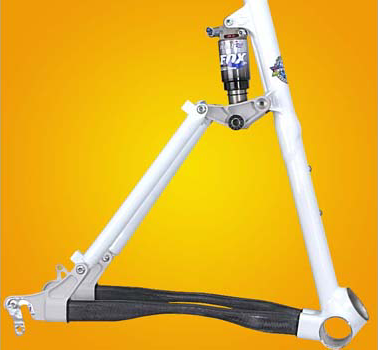
Figure 4.8)
The Scalpel is another tight-radius design. The bike was inspired by a “split-pivot mono” prototype, which can be viewed on the Cannondale web site.
Figure 4.8) shows a picture of the rear suspension, taken from Cannondale's web site (with permission). The thin, flexible section of the chain stays is meant to act like a pivot. The path tangent starts out at nearly vertical and curves forward. The chain stay length is initially increasing, since the BB is centered below the height of the rear axle. We have not bothered to plot the path, since the center of curvature is going to be at the thin part of the stays. The intended benefits, as explained on the Cannondale web site, are an increasing effective chain stay at sag, with a tight curvature to reduce bump feedback.

Figure 4.8)
There is not much more to say here, since the concepts are fairly straightforward. The one thing to add is that chain stay bending does not have to be localized, as it is in the Scalpel, to produce a rear axle path radius of curvature smaller then the wheel radius. However, there is a potential advantage in localizing the bend in that the exact curvature can be more precisely controlled.
The location of the bend in the Scalpel probably produces a radius of curvature similar to typical “soft-tail” designs. The initial path tangent is tilted just slightly more rearward, relative to typical soft-tails, since the bend is centered at the thin part of the stays near the top of what are otherwise rather thick stays.
The extremely short travel of most soft-tail designs makes the above path considerations essentially irrelevant. However, in the Scalpel, there may be just enough travel for the tight wheel path to make a difference in bump feedback. The limited travel means that the Scalpel will essentially have no big hit performance, so tight curvature is preempted as a drawback. As always, each rider should test ride, to determine for himself or herself, whether or not any of the design considerations are significant.